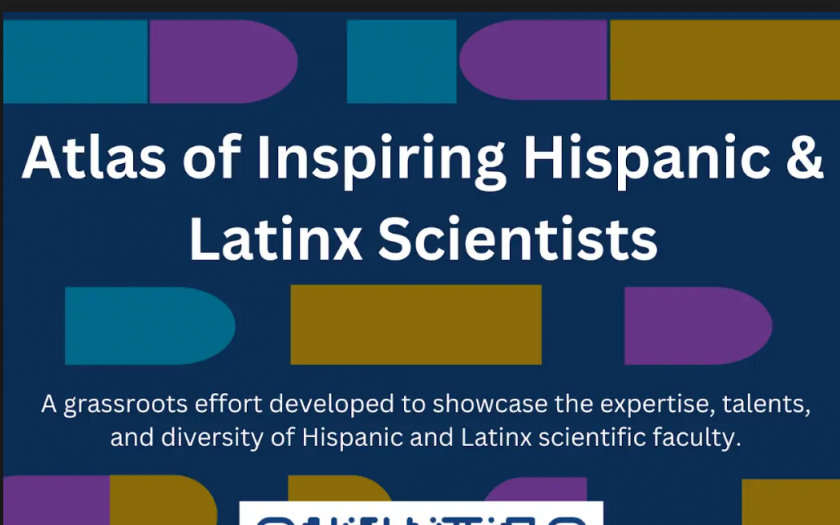Honoring Hispanic Heritage Month, Multi-Institution Team Launches The Atlas of Hispanic/Latinx Scientists

When Doris Cruz Alonso was looking for a Principal Investigator (P.I.) to conduct her P.h.D research under, she knew she wanted to work with a Latinx scientist. J.P. Flores, her mentor at the University of North Carolina - Chapel Hill’s (UNC) PREP program, told Doris about a list of 100 Inspiring Hispanics/Latinx Scientists. The list was so helpful in Doris’ search that J.P. and Doris hosted the creator of the list, Fred Hutchinson Cancer Center’s Dr. Christina Termini, on J.P.’s “From Where Does It STEM?” podcast.
That was where the idea for The Atlas of Hispanic/Latinx Scientists was born. The Atlas, which launched on September 15 in honor of the start of Hispanic Heritage Month, will serve as a public database of outstanding Latinx scientists and faculty members from institutions of higher education across the country.
Navigating The Atlas: “A Catch-all Resource”
Fred Hutchinson Cancer Center hosts the website. The 397 faculty members featured on The Atlas have short bios, featuring descriptions of their research interests, program affiliations, and academic background. Each individual has also agreed to share forms of contact information and their profiles link to lab websites.
“It’s basically a catch-all resource that serves as many people as possible,” said J.P.
Carolina Gomez-Casas—a member of The Atlas team and a third-year P.h.D candidate in biomedical engineering (BME) at Brown—said she could see the site being used by high school teachers looking to connect their students with professionals. When students are applying to college, “if you don’t see people that look like you or come from a similar background…you’re super discouraged,” Carolina said. The Atlas could be an avenue for helping Latinx high schoolers see themselves in STEM fields, she suggested.
J.P. said students could start navigating The Atlas even younger—elementary schoolers could access the site to find STEM inspirations or to reach out to scientists for class projects.
The Atlas also serves as a way to bring Latinx scientists together. “It’s so rewarding seeing all these scientists (email us) being like ‘oh my gosh, I’m so excited for this thing to come out. I can’t wait to see who else is on the list so that we can talk to each other,’” J.P. said.
Creating the Atlas: “An Overwhelming Process”
Inspired by Dr. Termini’s work, J.P.—a Ph.D. candidate in Bioinformatics and Computational Biology at UNC—and Doris—a Ph.D. student in Biomedical Sciences at the University of Michigan—developed the idea for The Atlas. Their friend from the UNC PREP program, University of Virginia biomedical sciences Ph.D. student Crystal Dezha-Bolteada, then joined the team. Brown BME Ph.D. candidate Carolina then got involved after hearing J.P. present at a conference at Brown. With their team complete, the group’s work exploded.
“It was kind of an overwhelming process,” said Doris. Dr. Termini started by sending about 50 emails to Latinx faculty members at institutions across the country. Those faculty were invited to nominate other scientists to the list, and soon the team was receiving hundreds of emails.
J.P. organized everyone’s information into a spreadsheet, trying to ensure no scientists would accidentally appear twice on the database. Doris and Crystal sent out thank you letters to everyone who filled out their survey or responded to their emails.
Throughout the process, the team was continuously receiving positive feedback from faculty. “Reading those emails was so satisfying,” said Doris. “There were even a couple of P.I.s from Brown…I was so excited!” added Carolina.
Expanding The Atlas: “This Community Will Be Growing”
Despite working at institutions across the country—Doris at the University of Michigan, J.P. at UNC, Crystal at the University of Virginia, Carolina at Brown, and Dr. Teremini at Fred Hutchinson—the team grew close. “I’ve only been to Brown twice in my life,” J.P. said. Now, “if I’m ever in the Northeast, I’ll hit (Carolina) up.”
That closeness will make it easier for the team to continue working together as they try and expand The Atlas to serve even more needs. Right now, The Atlas features 397 tenure-track faculty. The team hopes faculty who aren’t already featured will see the site and reach out to have themselves added.
They’ve also had interest from scientists who work outside of academia. “Hopefully we can expand by sector,” said J.P. “The next generation of Hispanic/Latinx scientists, maybe they want to go into industry…maybe they want to go into policy.” J.P. hopes that The Atlas will be able to feature experts from those sectors in the future.
“I see this as a resource that can also be a model for other diverse scientists,” J.P. said. He hopes other people will see The Atlas and create their own versions for Black scientists, Indigenous scientists, and other historically underrepresented groups.
Please submit this form to nominate yourself or another scientist to be added to The Atlas.
Please submit this form to nominate non-faculty scientists to be added to The Atlas.